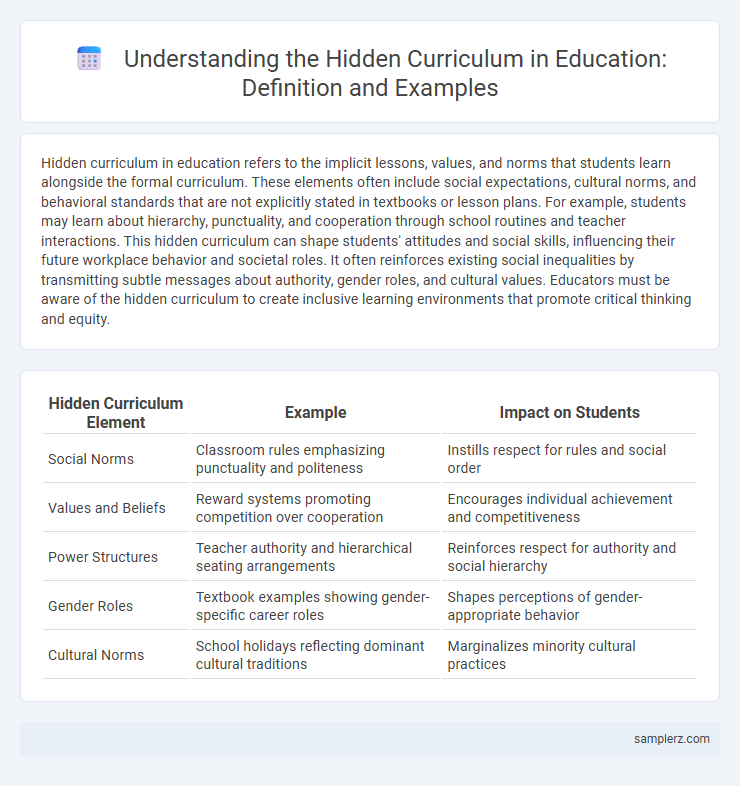Hidden curriculum in education refers to the implicit lessons, values, and norms that students learn alongside the formal curriculum. These elements often include social expectations, cultural norms, and behavioral standards that are not explicitly stated in textbooks or lesson plans. For example, students may learn about hierarchy, punctuality, and cooperation through school routines and teacher interactions. This hidden curriculum can shape students' attitudes and social skills, influencing their future workplace behavior and societal roles. It often reinforces existing social inequalities by transmitting subtle messages about authority, gender roles, and cultural values. Educators must be aware of the hidden curriculum to create inclusive learning environments that promote critical thinking and equity.
Table of Comparison
| Hidden Curriculum Element | Example | Impact on Students |
|---|---|---|
| Social Norms | Classroom rules emphasizing punctuality and politeness | Instills respect for rules and social order |
| Values and Beliefs | Reward systems promoting competition over cooperation | Encourages individual achievement and competitiveness |
| Power Structures | Teacher authority and hierarchical seating arrangements | Reinforces respect for authority and social hierarchy |
| Gender Roles | Textbook examples showing gender-specific career roles | Shapes perceptions of gender-appropriate behavior |
| Cultural Norms | School holidays reflecting dominant cultural traditions | Marginalizes minority cultural practices |
Unveiling the Hidden Curriculum in Schools
Hidden curriculum in schools includes unspoken social norms, values, and beliefs that shape student behavior and attitudes beyond the formal syllabus. Practices like reinforcing gender roles, encouraging competition, or promoting conformity often transmit implicit lessons affecting students' social development and identity formation. Recognizing these subtle influences allows educators to foster more inclusive and equitable learning environments by addressing biases embedded in everyday interactions and institutional policies.
Implicit Values Transmitted Through Classroom Practices
Classroom practices often transmit implicit values such as cooperation, resilience, and respect through group work, disciplinary measures, and teacher-student interactions. These hidden curriculum elements shape students' social behavior and attitudes without explicit instruction. For example, consistently emphasizing punctuality and participation subtly reinforces the importance of responsibility and engagement in academic and professional settings.
Social Norms Learned Beyond Academic Content
Students often absorb social norms and cultural expectations through implicit cues embedded in classroom interactions and teacher behaviors, shaping their understanding of appropriate social conduct. These hidden lessons include developing punctuality, respect for authority, collaboration skills, and attitudes towards diversity, which are not explicitly stated but crucial for social integration. Such social norms learned beyond academic content influence students' future workplace behavior and societal participation.
Teacher Attitudes as Hidden Lessons
Teacher attitudes often serve as hidden lessons within the curriculum, subtly influencing student perceptions and classroom dynamics. These attitudes can shape students' motivation, self-esteem, and engagement, imparting values and social norms beyond the explicit content. Recognizing and addressing these implicit messages is crucial for fostering an inclusive and supportive educational environment.
Reinforcement of Gender Roles in School Activities
School activities often reinforce traditional gender roles by assigning tasks and roles based on gender stereotypes, such as boys leading sports teams while girls are encouraged to join dance or cheerleading squads. This hidden curriculum subtly perpetuates societal expectations, influencing students' perceptions of appropriate behaviors and career paths. Such reinforcement limits the development of diverse skills and discourages students from exploring non-traditional roles.
Unspoken Expectations Around Student Behavior
Unspoken expectations around student behavior, such as punctuality, participation, and adherence to classroom norms, often remain hidden in the curriculum but significantly influence academic success. These implicit behavioral codes shape classroom dynamics and impact teacher evaluations, peer interactions, and access to opportunities. Understanding and addressing these hidden norms is crucial for creating equitable learning environments where all students can thrive.
Socioeconomic Messages Embedded in School Structure
Socioeconomic messages are embedded in school structures through disparities in resource allocation, such as funding differences between public and private schools or affluent and low-income districts. These structural inequalities influence students' educational experiences, reinforcing social stratification and limiting upward mobility. Curriculum often omits critical discussions on economic inequality, implicitly perpetuating the status quo by normalizing disparities.
Cultural Biases Present in Instructional Materials
Textbooks often portray historical events and cultural narratives from a dominant cultural perspective, leading to the marginalization of minority groups in educational content. Instructional materials may exclude diverse contributions or depict stereotypes that reinforce cultural biases, affecting students' understanding and self-identity. Addressing hidden cultural biases requires revising curricula to include inclusive voices and multicultural perspectives that reflect the diversity of student populations.
Power Dynamics and Authority in the Classroom Environment
Power dynamics and authority in the classroom manifest through hidden curriculum elements such as teacher-centered discourse, which positions students as passive recipients rather than active participants. Implicit rules governing participation, seating arrangements, and disciplinary measures reinforce hierarchical structures that privilege certain voices and marginalize others. These subtle cues shape students' perceptions of power, obedience, and resistance within educational settings, influencing their social development beyond formal lessons.
Developing Attitudes Toward Diversity Through Everyday Interactions
Classroom discussions and group projects often serve as hidden curriculum elements that subtly influence students' attitudes toward diversity by promoting empathy, respect, and open-mindedness. Teachers' everyday interactions, including language choices and nonverbal cues, reinforce inclusive values and challenge stereotypes without explicit instruction. This implicit social learning shapes students' perceptions and behaviors, fostering a more accepting and culturally aware school environment.

example of hidden in curriculum Infographic
 samplerz.com
samplerz.com